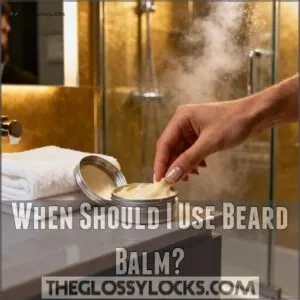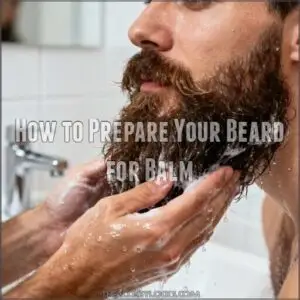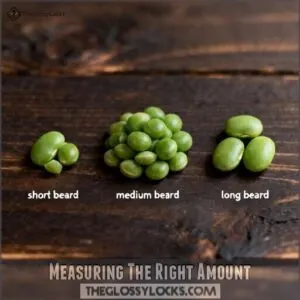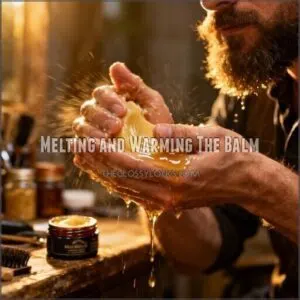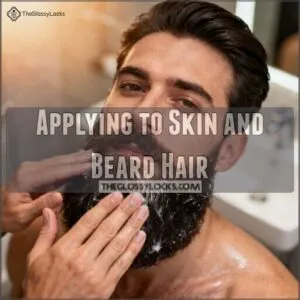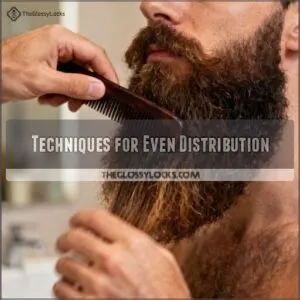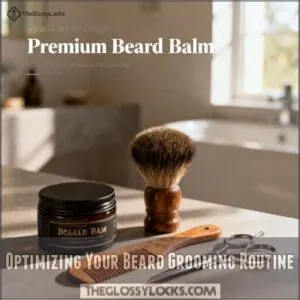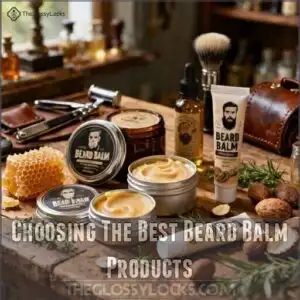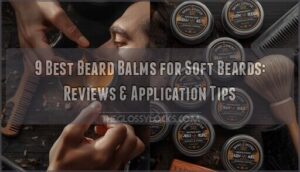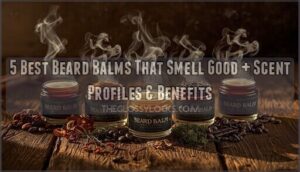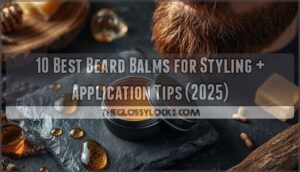This site is supported by our readers. We may earn a commission, at no cost to you, if you purchase through links.
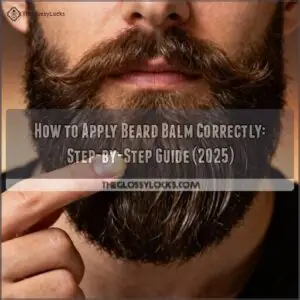 You’d be shocked how many guys glob beard balm into their whiskers like they’re frosting a cake, then wonder why their beard looks clumpy or greasy. The difference between a well-groomed beard and a disaster often comes down to technique—not the product itself.
You’d be shocked how many guys glob beard balm into their whiskers like they’re frosting a cake, then wonder why their beard looks clumpy or greasy. The difference between a well-groomed beard and a disaster often comes down to technique—not the product itself.
Most beard balm mistakes happen in those first 30 seconds of application, turning quality ingredients into wasted potential. Getting the temperature right, working from skin to tip, and using the correct amount transforms beard balm from a confusing goop into your beard’s best friend.
Once you nail the proper method, you’ll tame flyaways, lock in moisture, and style your beard with confidence—all without that heavy, overdone look that screams "I tried too hard.
Table Of Contents
Key Takeaways
- Most beard balm mistakes happen in the first 30 seconds—warming it between your palms until it melts, working it into the skin first (not just the hair), and using the right amount (pea-sized for short beards, almond-sized for long ones) transforms it from a clumpy mess into an effective grooming tool.
- Timing matters as much as technique—apply balm post-shower when your beard is damp and clean to lock in maximum moisture, or use it before bed for overnight conditioning that prevents dryness, itching, and wiry texture.
- Beard balm outperforms oil for styling because beeswax provides actual hold and control, making it essential for taming flyaways and shaping medium-to-long beards, while oil just absorbs quickly without sculpting power.
- Even distribution is the secret to avoiding that "tried too hard" look—after applying balm to skin and hair, comb or brush downward in multiple passes to align every strand, prevent clumps, and achieve that polished, well-groomed finish.
What Does Beard Balm Do?
Beard balm isn’t just one of those grooming products that sits on your shelf looking fancy—it actually pulls its weight. Think of it as your beard’s best friend, packing moisturizing power, styling hold, and conditioning benefits all into one container.
Let’s break down exactly what this grooming MVP brings to your daily routine.
Key Ingredients and Their Benefits
Think of beard balm as your beard’s best friend—packed with shea butter, beeswax, and essential oils that team up to soften, strengthen, and style your facial hair while keeping the skin underneath healthy and happy.
Shea butter and cocoa butter deliver deep moisture, while argan oil addresses dry, brittle hairs. Beeswax benefits include light hold for styling without stiffness.
These organic ingredients work together like a well-oiled machine—keeping your beard looking sharp and feeling great.
Moisturizing and Conditioning Effects
When those natural butters and oils soak into your beard, they’re doing more than just sitting on the surface—they’re actually penetrating each hair shaft and the skin below to lock in moisture and prevent the dryness that leads to itching, flaking, and that wiry texture nobody wants.
Here’s what consistent beard balm application delivers:
- Itch relief and dandruff reduction—over 80% of users report fewer flakes after four weeks of regular moisturizing
- Softness improvement—beard conditioning benefits include a 70% reduction in unruliness for medium-to-long beards
- Shine enhancement—balm hydration levels keep your beard looking healthy without that greasy feel
Styling and Hold for Different Beard Types
Beyond the moisture magic, beard balm gives you something beard oil can’t—actual control over your facial hair, thanks to the beeswax that acts like a sculptor’s clay for your face.
Length matters when applying beard balm—short beard hairs need just fingertip styling techniques, while longer beards demand more product and deliberate beard styling to tame flyaways and shape your look.
Here’s how balm consistency works across beard types:
| Beard Type | Hold Strength Needed | Styling Tools |
|---|---|---|
| Short (1-2 inches) | Light hold | Fingers or comb |
| Medium (2-4 inches) | Medium hold | Brush and comb |
| Long (4+ inches) | Strong hold | Wide-tooth comb |
| Curly/Unruly | Extra firm | Boar bristle brush |
Comparison to Beard Oil
Beard oil and beard balm share ingredient overlap—both use carrier oils and essential oils—but texture differences set them apart. Oil absorbs fast and feels lightweight, while balm has a thicker, waxier consistency that provides hold strength for styling.
Beard balm application involves warming and sculpting, whereas applying beard oil is a quick massage-through. Both products help mitigate the loss of natural oils, also known as sebum production.
Scent profiles vary, but balm’s beeswax gives you control oil simply can’t match—that’s the real difference between beard oil and balm.
When Should I Use Beard Balm?
Timing your beard balm application right makes all the difference in how your beard looks and feels. Whether you’re a daily groomer or a weekend warrior, knowing when to reach for that tin can save you from a scraggly mess.
Let’s break down the best times to apply balm, how often you should use it, and what your beard length and the weather have to do with it.
Ideal Times for Application
Timing your beard balm application right can mean the difference between a well-groomed masterpiece and a frizzy disaster—so let’s talk about when to reach for that tin.
Post-shower is your golden window—your beard’s damp, clean, and ready to lock in moisture. Before bed works wonders too, letting the beard balm benefits work overnight.
After workouts, special occasions, or during travel? Perfect times to tame flyaways and refresh your beard care routine.
Daily Vs. Occasional Use
Most bearded guys fall into one of two camps: the daily devotees who wouldn’t skip a day, or the weekend warriors who only break out the tin when their beard starts looking like a tumbleweed. Your usage frequency depends on beard length, skin sensitivity, and lifestyle factors—longer beards benefit from daily grooming routine application, while shorter styles can get by with occasional touch-ups.
Here’s how to decide your beard balm application steps:
- Daily use keeps medium to long beards soft and tames unruly hairs consistently
- Every-other-day application works for shorter beards or sensitive skin prone to product buildup
- Weather impacts frequency—dry winter air demands more moisturizing than humid summers
- Active lifestyles benefit from post-workout applications to refresh and control flyaways
- Skip days when your beard feels greasy to avoid over-conditioning and maintain natural balance
Seasonal and Beard Length Considerations
Your beard’s needs shift with the seasons and length—winter’s dry air demands heavier balms packed with moisture to prevent brittleness, while summer calls for lighter climate balm types that won’t clog pores.
Length-based amounts matter too: short beards need pea-sized portions for control, but longer styles require almond-sized scoops to maintain beard health impact and styling hold throughout the day.
During the summer months, it’s also important to think about UV protection to prevent sun damage.
How to Prepare Your Beard for Balm
Think of preparing your beard like prepping a canvas before painting—you need a clean, dry surface for the balm to work its magic. A little prep goes a long way in making sure the product actually does its job instead of just sitting on top.
Here’s what you need to do before reaching for that tin.
Cleansing and Drying The Beard
Think of your beard like a canvas—you wouldn’t start painting without prepping the surface first, right? Start your beard grooming routine by washing with a quality beard wash and warm water to remove dirt and oils.
Expert recommendations suggest thorough drying—pat it down with a towel instead of rubbing. Proper beard care means the balm absorbs better, and drying techniques matter for product compatibility.
Checking Skin and Beard Health
Before you slather on that balm, take a quick look at what’s happening beneath the whiskers—redness, flaking, or itchiness are signs your skin needs attention first. Irritation indicators like rough patches or beard itch might signal underlying conditions needing treatment.
Checking your skin health and beard health helps with dandruff prevention and makes certain you’re not masking problems. If you’ve got patchy growth or skin sensitivity, address those issues before moving forward.
Avoiding Product Build-up
Layering product after product without clearing the slate is like painting over old paint—eventually, you’re just making a mess. Proper cleansing prevents residue removal nightmares and keeps your beard grooming game strong.
Stick to the right product quantity—a pea-sized amount does the trick—and dial back your application frequency if things feel gunky. When applying beard balm for beginners, less beats more every time, dodging product buildup before it starts.
Step-by-Step Beard Balm Application
Alright, you’ve got your beard prepped and ready—now it’s time for the main event. Applying beard balm isn’t rocket science, but doing it right makes all the difference between a scraggly mess and a beard that looks like you mean business.
Let’s break down the process step-by-step so you can nail it every time.
Measuring The Right Amount
Most guys grab way too much balm on their first try, turning their beard into a greasy mess instead of the sharp, well-groomed look they’re after. Here’s your balm quantity guide based on beard length impact:
- Short beards (1-2 inches): Half a pea-sized amount works perfectly
- Medium beards (2-4 inches): Full pea-sized amount is ideal
- Long beards (4+ inches): Two pea-sized portions maximum
- Sensitive skin: Start smaller, adjust application frequency
- High product concentration: Less goes further with quality balms
Your beard styling techniques improve when you nail the pea-sized amount from the start.
Melting and Warming The Balm
Cold balm straight from the tin is stubborn as a rock—rubbing it between your palms transforms it into a smooth, workable oil that’ll glide right into your beard.
Friction generation heats the beard balm ingredients (like beeswax and shea butter), changing balm consistency from solid to liquid in seconds.
Rub that peasized amount vigorously between your hands until you’ve got ideal temperature for application readiness—no clumps, no residue prevention issues.
Applying to Skin and Beard Hair
Once that balm’s melted down, your first move is working it into the skin beneath your beard—think of it like watering the roots before you tend to the leaves. Massage techniques matter here: use your fingertips to rub the product into your skin with gentle application pressure, promoting skin absorption and preventing flakiness.
Then sweep upward through your beard hair, ensuring complete hair coverage without leaving product residue behind.
Techniques for Even Distribution
Now that you’ve got the balm in place, grab your beard comb or brush and work it through in downward strokes—this is where you turn that oily mess into a polished, evenly coated masterpiece. Focus on application direction and comb techniques to guarantee proper product absorption without avoiding clumps.
Here’s what matters most:
- Stroke downward to align every hair and lock in that styling hold
- Work from roots to tips for complete coverage and smoother beard grooming
- Comb multiple passes to prevent layering balm unevenly across sections
Optimizing Your Beard Grooming Routine
You’ve nailed the application—now let’s lock in the results. The right tools and habits make all the difference between a scruffy mess and a beard that turns heads.
Here’s how to keep your beard looking sharp and feeling healthy day after day.
Using Combs and Brushes for Styling
After you’ve worked the balm into your beard, grab your comb or brush—think of it as your sculpting tool that transforms a messy canvas into a masterpiece.
A wooden beard comb glides smoothly through hairs, training them downward while distributing the beard balm evenly. For volume control and styling techniques, use a boar bristle beard brush in upward strokes, then shape your look with deliberate combing motions that tame flyaways.
Tips for Maintaining Beard Health
Beyond simply applying beard balm, your beard grooming depends on solid hydration strategies—drinking 64 oz of water daily—and nutritional factors like protein and biotin.
Hygiene practices matter too: wash 2–3 times weekly to prevent skin issues like dandruff and irritation.
For growth enhancement, massage your face 5–10 minutes daily to boost blood flow, and trim regularly to remove split ends while maintaining beard health and overall beard care consistency.
Choosing The Best Beard Balm Products
Not all beard balms are created equal, and picking the right one can make or break your grooming game. The ingredients matter, the brand matters, and yeah—what other guys are buying matters too.
Let’s break down what you need to know before you grab that tin off the shelf.
Natural Vs. Synthetic Ingredients
When you’re scanning the shelves for beard balm, the choice between natural and synthetic ingredients isn’t just about reading labels—it’s about what you’re willing to put on your face every single day. Natural oils, beeswax, and shea butter generally win on ingredient efficacy and skin sensitivity, especially if you’re prone to skin irritation.
Synthetic options might save you a few bucks in cost comparison, but they often lack the environmental impact credentials and sourcing ethics that natural beard balms bring to the table.
Reviewing Popular Kits (e.g., Beard Club Enhanced Growth Kit)
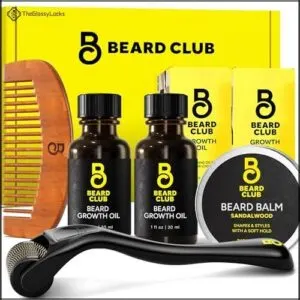
If you’re serious about leveling up your beard game, all-in-one kits like The Beard Club Enhanced Growth Kit pack a powerful punch—combining derma roller technology, growth oil, sandalwood balm, and a wooden comb into one unified arsenal.
At $44.99, this kit’s ingredients list boasts natural oils like Castor, Cedar, and Avocado, all cruelty-free and vegetarian.
User experiences vary—some guys rave about the growth claims and daily results, while others find the scent strong or feel the value assessment doesn’t match their expectations.
Market Trends and Consumer Preferences
The beard balm market is booming, and understanding what’s driving those sales can help you pick products that actually deliver instead of just riding the trend wave. Here’s what’s shaping beard grooming products right now:
- Organic popularity accounts for nearly half of all balm sales—guys want natural ingredients they can trust
- Online sales dominate with over 60% of purchases happening digitally, making customer favourites easy to spot
- Daily usage by 64% of users proves the benefits of beard balm aren’t just hype
- Regional growth in Asia-Pacific shows beard products order expanding globally beyond traditional markets
Frequently Asked Questions (FAQs)
Can I use beard balm on stubble?
Yes, you can use beard balm on stubble. Balm ingredients moisturize skin and soften facial hair, reducing sensitivity and irritation.
Apply sparingly—stubble needs less product than longer beards—to support healthy beard grooming and care from the start.
How long does beard balm last once opened?
Most beard grooming products maintain their shelf life for 12-18 months once opened, though storage conditions matter. Keep your Beard Balm sealed tight, away from heat and sunlight.
Sniff for rancid odors or check for color changes—these expiration signs mean it’s time to replace it.
Can beard balm cause allergic reactions or irritation?
Absolutely—ingredient sensitivities can trigger allergic reactions or skin irritation. Patch testing helps you spot reaction symptoms early, like itchiness or redness on facial skin.
Check balm ingredients for common irritants to prevent issues with beard balm before full application.
Should I wash out beard balm before bed?
You might think leaving beard balm overnight sounds messy, but it’s actually beneficial. No need to wash it out—quality beard balm absorbs fully, delivering overnight benefits without causing skin irritation or balm residue on your pillow.
Can women use beard balm for hair care?
Women can absolutely use beard balm for hair care. The moisturizer works great on dry ends, frizz, and flyaways.
Natural butters condition hair beautifully, though styling adaptability depends on hair texture.
Check ingredient safety and scent preferences first.
Conclusion
The gap between a scraggly mess and a beard that turns heads is smaller than you think—it’s all in how to apply beard balm correctly. Once you’ve got the warming, distributing, and brushing down, you’re not just grooming; you’re engineering a masterpiece.
Your beard won’t just look better—it’ll feel healthier, behave on command, and give you that swagger that only comes from knowing you’ve nailed it. Skip the guesswork, stick to the method, and watch your facial hair game level up.
- https://www.unrulybeard.ca/post/best-way-to-apply-beard-balm
- https://www.thegroomedmanco.com/blogs/beards/does-beard-balm-help-your-beard-grow
- https://docs.google.com/forms/d/1GAQr3Kn1cURCVHUA82hAga1Wv8DCH0IuqDLRUrOpN7M/viewform?ts=63f4f653&entry.1515682415=https://www.merriam-webster.com/dictionary%2Fapply
- https://premium.britannica.com/mw-unabridged/?utm_source=mw&utm_medium=inline-def&utm_campaign=evergreen
- http://blog.thebeardclub.com/2018/08/05/best-essential-oils-for-beard-growth/

